A guide camera is an essential tool in photography‚ designed to help users capture high-quality images. It offers versatility‚ key features‚ and ease of use for creative control.
1.1 What is a Guide Camera?
A guide camera is a photography tool designed to assist users in capturing high-quality images. It typically features manual controls and advanced settings‚ allowing for precise adjustments. These cameras often include modes like aperture priority and shutter speed control‚ enabling photographers to achieve specific effects. Guide cameras are user-friendly‚ catering to both professionals and newcomers‚ and are built to enhance creativity and precision in photography.
1.2 Importance of Guide Cameras in Photography
A guide camera plays a vital role in photography by offering precise control over settings like aperture and shutter speed. It helps photographers understand fundamental concepts‚ enabling better composition and lighting techniques. Guide cameras bridge the gap between automatic and manual photography‚ making them ideal for learning and creativity. Their adaptability ensures high-quality results in various conditions‚ making them indispensable for both professionals and newcomers aiming to enhance their photography skills.
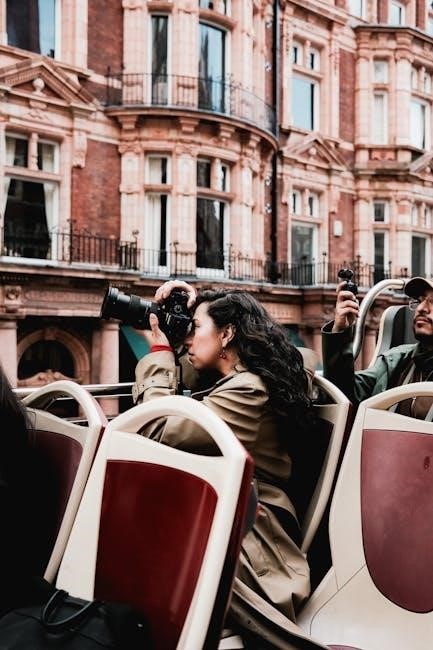
Types of Guide Cameras
Guide cameras come in various forms‚ including DSLR‚ mirrorless‚ and point-and-shoot models. Each type offers unique features‚ catering to different photography needs and skill levels.

2.1 DSLR Cameras
DSLR (Digital Single-Lens Reflex) cameras are popular for their versatility and image quality. They use a mirror and prism system to view scenes through the lens‚ offering precise control. With manual modes and interchangeable lenses‚ DSLRs are ideal for professionals and enthusiasts. Key features include advanced autofocus‚ weather sealing‚ and long battery life. They excel in various genres‚ from portraits to wildlife photography‚ making them a reliable choice for creative expression and technical precision.
2.2 Mirrorless Cameras
Mirrorless cameras are modern‚ compact alternatives to DSLRs‚ eliminating the mirror system for a lighter design. They use an electronic viewfinder or LCD for previewing shots‚ offering faster autofocus and burst modes. With interchangeable lenses‚ mirrorless cameras deliver high image quality and versatility. They are ideal for videography and travel photography‚ providing advanced features like 4K video and in-body stabilization. Their portability and performance make them a favorite among professionals and enthusiasts seeking convenience without compromising on results.
2.3 Point-and-Shoot Cameras
Point-and-shoot cameras are compact‚ user-friendly devices designed for casual photography. They feature automatic settings‚ built-in lenses‚ and ease of use‚ making them ideal for quick captures. With autofocus‚ auto-flash‚ and scene modes‚ they simplify photography for beginners. While they lack manual controls and interchangeable lenses‚ their portability and convenience make them perfect for everyday use‚ travel‚ or social events. They are a practical choice for those seeking simplicity and instant results without the complexity of advanced systems.

Understanding Camera Modes
Camera modes are essential for controlling exposure‚ allowing photographers to balance aperture‚ shutter speed‚ and ISO. They offer flexibility‚ catering to diverse shooting scenarios and creative goals effectively.
3.1 Manual Mode
Manual Mode offers full control over aperture‚ shutter speed‚ and ISO‚ allowing photographers to customize exposures precisely. It is ideal for experienced users seeking creative freedom. By adjusting these settings‚ photographers can achieve specific effects like motion blur or depth of field. Manual Mode requires a good understanding of exposure principles but provides unparalleled flexibility. It is particularly useful in challenging lighting conditions or when specific artistic effects are desired. A built-in exposure meter helps guide adjustments for optimal results.
3.2 Aperture Priority Mode
Aperture Priority Mode allows photographers to set the aperture‚ while the camera automatically adjusts the shutter speed and ISO for optimal exposure. This mode is ideal for controlling depth of field‚ enabling creative decisions about what is in focus. It simplifies shooting while maintaining artistic control‚ making it suitable for various lighting conditions. Photographers can experiment with different apertures to achieve desired effects‚ such as blurred backgrounds or sharp landscapes‚ without manual adjustments for every shot.
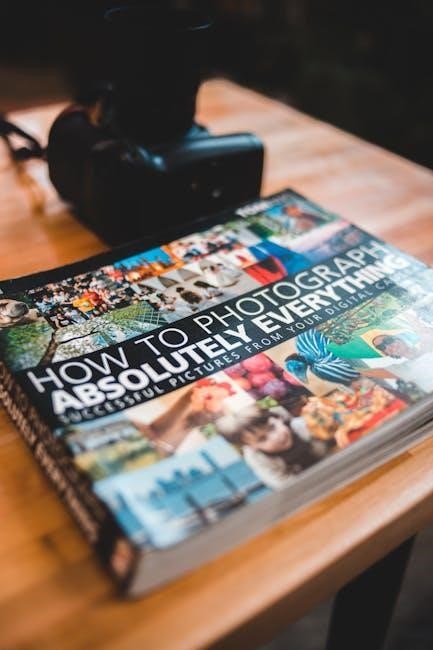
3.3 Shutter Priority Mode
Shutter Priority Mode lets photographers set the shutter speed‚ while the camera automatically adjusts the aperture and ISO for proper exposure. This mode is ideal for capturing motion‚ allowing control over freezing fast-moving subjects or creating artistic blur. It’s particularly useful for sports‚ wildlife‚ and action photography‚ where motion effects are crucial. By setting the shutter speed‚ users can achieve desired visual effects‚ such as sharp images of moving objects or creative blurring of water or clouds‚ while the camera manages the rest for optimal results.
3.4 Auto Mode
Auto Mode is a fully automatic setting where the camera controls all parameters‚ including aperture‚ shutter speed‚ and ISO. Designed for simplicity‚ it’s perfect for beginners or quick shots. The camera analyzes the scene and adjusts settings to deliver a balanced exposure. While it limits creative control‚ Auto Mode ensures sharp‚ well-exposed images in various conditions. It’s ideal for casual photography‚ such as family gatherings or travel‚ where ease of use is prioritized over manual adjustments. This mode makes photography accessible to everyone‚ regardless of skill level.
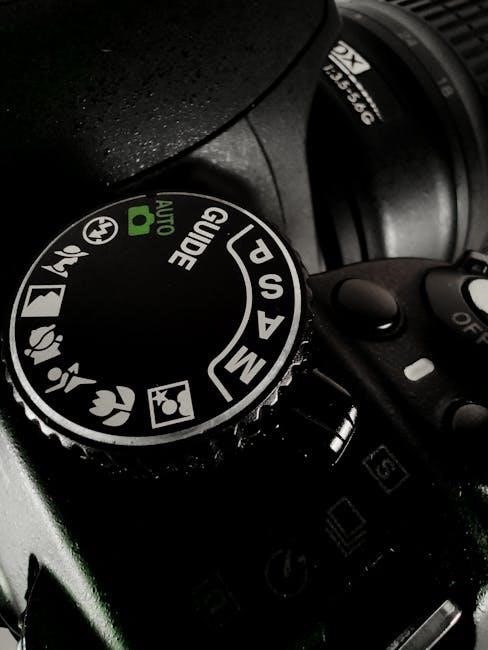
Key Components of a Guide Camera
A guide camera features essential components like the image sensor‚ lenses‚ ISO settings‚ and autofocus system‚ each vital for capturing high-quality images effectively.
4.1 Image Sensor
The image sensor is a critical component of a guide camera‚ responsible for capturing light and converting it into digital data. It plays a key role in determining image quality‚ with factors like sensor size and megapixel count impacting resolution. Larger sensors generally allow more light‚ enhancing performance in low-light conditions. Modern image sensors also feature advanced technologies to improve dynamic range and color accuracy‚ ensuring vibrant and detailed photos. Proper sensor functionality is vital for achieving professional-grade results in photography.
4.2 Lenses
Lenses are a fundamental part of a guide camera‚ directly influencing image quality and composition. They come in various types‚ including prime‚ zoom‚ wide-angle‚ and telephoto‚ each offering unique capabilities. The focal length determines the angle of view‚ while aperture affects light intake and depth of field. High-quality lenses minimize distortions and enhance clarity‚ ensuring sharp and vibrant images. Interchangeable lenses provide flexibility‚ allowing photographers to adapt to different shooting scenarios and creative visions. Proper lens selection is crucial for achieving desired visual effects in photography.
4.3 ISO Settings
ISO settings control the camera’s sensitivity to light‚ enabling adjustments in various lighting conditions. Lower ISO values (e.g.‚ ISO 100) are ideal for bright environments‚ producing minimal noise. Higher ISOs (e.g.‚ ISO 6400) are used in low light but may introduce grain or noise. Modern guide cameras offer wide ISO ranges‚ ensuring flexibility. Proper ISO selection balances image quality and lighting needs‚ crucial for achieving desired results in photography without compromising clarity or detail.
4.4 Autofocus System
The autofocus system in a guide camera is a critical feature that enables quick and precise focusing on subjects. It uses advanced algorithms and sensors to detect and lock onto targets‚ ensuring sharp images. Modern systems often include phase-detection or contrast-detection technologies for faster and more accurate focus acquisition. Customizable settings allow photographers to tailor autofocus behavior to specific scenarios‚ such as tracking moving subjects or achieving fine focus in low-light conditions. This feature is essential for capturing dynamic and professional-quality photos with ease and efficiency.

Composition Tips for Guide Camera Users
Mastering composition enhances your photography. Use the rule of thirds‚ leading lines‚ and framing techniques to create visually appealing and balanced images with your guide camera.
5.1 Rule of Thirds
The rule of thirds is a fundamental composition technique where the frame is divided into thirds both horizontally and vertically. By placing your subject off-center at one of the intersection points‚ you create a more balanced and visually appealing image. This method helps avoid a static‚ centered composition and draws the viewer’s eye naturally through the scene. Guide cameras often feature grid displays to assist in applying this technique effectively‚ ensuring your photos are dynamic and engaging. Proper use enhances storytelling and adds professional polish to your work.
5.2 Lighting Techniques
Lighting is a critical element in photography‚ and guide cameras offer tools to optimize its use. Natural light‚ such as the golden hour‚ creates warm tones and soft shadows‚ enhancing depth. Artificial light‚ like flashes or lamps‚ provides control over brightness and direction. Techniques include backlight for silhouettes‚ side lighting for texture‚ and diffused light for softness. Guide cameras often feature built-in flashes and adjustable settings to balance exposure‚ ensuring well-lit and visually striking images. Proper lighting enhances mood‚ highlights subjects‚ and elevates the overall quality of your photos.
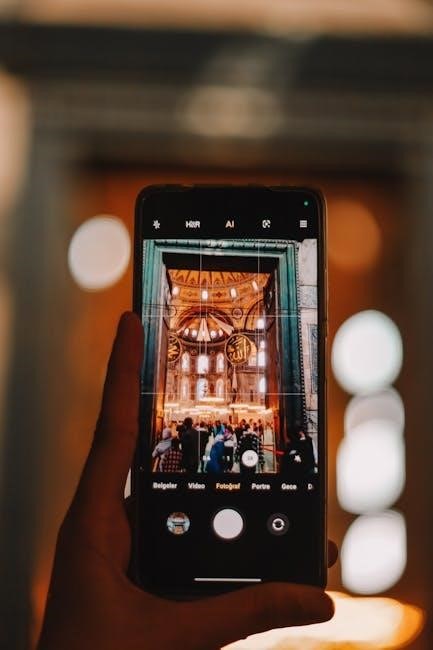
Maintenance and Care for Guide Cameras
Regularly clean lenses and camera bodies with microfiber cloths to prevent smudges. Store in cool‚ dry places to avoid humidity damage. Update firmware for optimal performance.
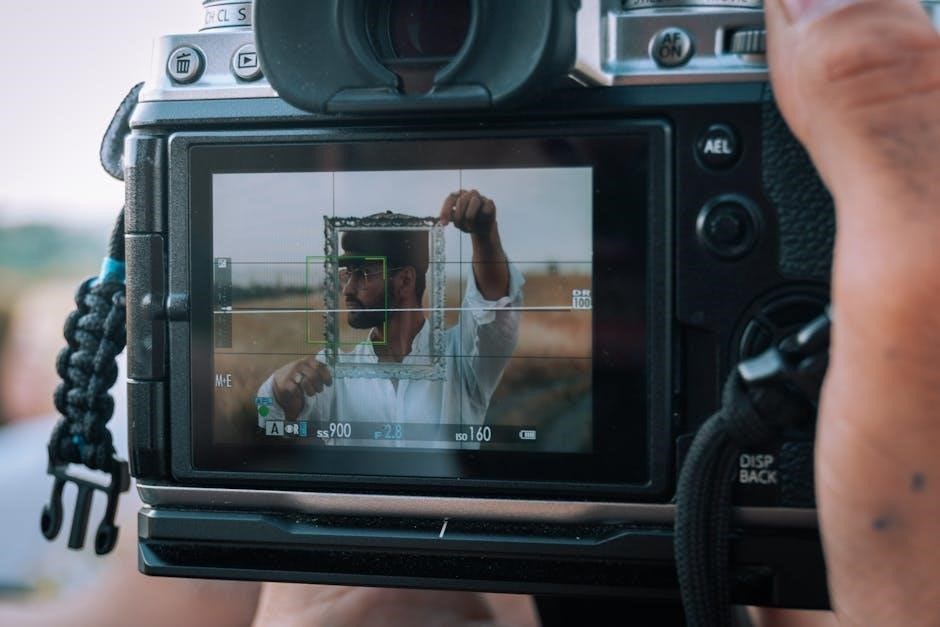
6.1 Cleaning the Camera and Lenses
Regular cleaning is crucial for maintaining image quality. Use a microfiber cloth to gently wipe lenses and the camera body‚ removing fingerprints and smudges. For stubborn spots‚ apply a lens cleaning solution with a soft‚ circular motion. Avoid harsh chemicals or abrasive materials that could scratch surfaces. Clean the viewfinder and LCD screen with specialized wipes or a microfiber cloth dampened with distilled water. This ensures clarity and prevents debris from affecting your shots. Clean your gear after each use to prolong its lifespan and performance.
6.2 Proper Storage
Proper storage is vital to protect your guide camera from damage. Store the camera in a dry‚ cool place‚ away from direct sunlight and moisture. Use a protective case or bag to shield it from dust and physical damage. Keep the camera and lenses separate to prevent scratching. Avoid extreme temperatures‚ as they can harm the electronics and battery. Consider using silica gel packets to absorb moisture. For long-term storage‚ ensure the battery is fully charged or removed to prevent degradation. Always store the camera in an upright position to maintain lens alignment.
6.3 Software and Firmware Updates
Regular software and firmware updates are essential for maintaining your guide camera’s performance. These updates often improve functionality‚ fix bugs‚ and enhance compatibility with new lenses or accessories. Always download updates from the manufacturer’s official website to ensure authenticity. Follow the provided instructions carefully to avoid errors. Use a fully charged battery or connect to an AC adapter during the process to prevent interruptions. Back up your custom settings before updating‚ as they may reset to default. Updates ensure optimal camera operation and access to the latest features.
Troubleshooting Common Issues

Troubleshooting common issues with your guide camera can enhance your photography experience. Check for error messages‚ as they often indicate specific problems like lens or memory card issues. Ensure settings are correctly configured‚ as incorrect modes or ISO levels can lead to unexpected results. Clean the camera and lenses regularly to avoid blurry images. If the camera fails to turn on‚ check the battery or power source. Restarting the camera may resolve software glitches. Always refer to the user manual or manufacturer support for detailed solutions to specific problems.
